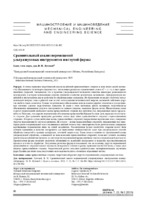Сравнительный анализ перемещений ультразвуковых инструментов изогнутой формы
Another Title
Comparative Analysis of Movements of Curved Ultrasonic Instruments
Bibliographic entry
Луговой, В. П. Сравнительный анализ перемещений ультразвуковых инструментов изогнутой формы = Comparative Analysis of Movements of Curved Ultrasonic Instruments / В. П. Луговой // Наука и техника. – 2023. – № 2. – С. 96-102.
Abstract
В статье приведен теоретический анализ колебаний криволинейного стержня в виде петли малой жесткости, образованного из четверти окружности с постоянным радиусом, ограниченного углом π/2 < γ < π, и двух прямолинейных стержней. Указывается, что в практике ультразвуковой технологии известны некоторые разновидности конструкций, в которых использованы упругие элементы в качестве резонаторов, волноводов, трансформаторов колебаний и инструментов для воздействия на обрабатываемые материалы. Их применение позволяет получить дополнительный импульс силы в рабочей зоне за счет использования потенциальной энергии, вызванной действием упругих свойств таких элементов. Однако теоретическому обоснованию использования упругих элементов в ультразвуковых системах уделено недостаточное внимание. В связи с этим настоящая работа посвящена теоретическому обоснованию применения упругого инструмента из тонкого стержня, имеющего форму петли. Представлены схема и расчет перемещений свободного конца криволинейного стержня под действии сил, направленных вдоль продольной оси. Показано, что упругие перемещения обусловлены криволинейной формой в виде дуги окружности изогнутого стержня. Для сравнения приведены расчетные схемы двух типов криволинейного стержня с присоединенным стержнем. В первом случае свободные концы прямолинейных стержней, направленные вертикально вниз, совершают упругие перемещения по двум координатам. Во втором – концы прямолинейных стержней, направленные под неко- торым углом к вертикальной оси и сходящиеся в нижней точке в силу симметричности их расположения, совершают вертикальные перемещения лишь по одной координате. Рассмотренная форма изогнутого стержня может быть успешно применена в качестве инструмента для выполнения технологических задач при ультразвуковом способе обработки отверстий в хрупких материалах, точечной сварки и пр. Такая схема в отличие от традиционной схемы ультразвуковой обработки, основанной на использовании прямолинейных стержней, позволяет усилить величину амплитуды колебаний инструмента за счет упругих перемещений криволинейного участка стержня малой жесткости. Предложенная форма позволит увеличить интенсивность колебаний инструмента и повысить производительность процесса и точность обработки. Полученная расчетная формула показывает, что на величину упругих перемещений криволинейного стержней влияют жесткость поперечного сечения и радиус кривизны изогнутой части, а также угол наклона прямолинейного стержня. Теоретический расчет дополнен сравнительным экспериментальным изучением форм Хладни для обеих схем, полученных на поверхности листа с помощью абразивных частиц.
Abstract in another language
The paper presents a theoretical analysis of vibrations of a curvilinear rod in the form of a loop of low rigidity formed from a quarter of a circle with a constant radius, limited by an angle π/2 < γ < π and two rectilinear rods. It is indicated that in the practice of ultrasonic technology, some types of structures are known in which elastic elements are used as resonators, waveguides, oscillation transformers and instruments for influencing the processed materials. Their use makes it possible to obtain an additional impulse of force in the working area by using the potential energy caused by the action of the elastic properties of such elements. However, insufficient attention has been paid to the theoretical justification of the use of elastic elements in ultrasonic systems. In this regard, the present work is devoted to the theoretical substantiation of the use of an elastic tool made of a thin rod having the shape of a loop. The diagram and calculation of displacements of the free end of a curved rod under the action of forces directed along the longitudinal axis are given in the paper. It is shown that elastic displacements are caused by a curved shape in the form of an arc of a circle of a curved rod. For comparison, calculation schemes of two types of curved rod with an attached rod are given. In the first case, the free ends of the rectilinear rods, directed vertically downwards, make elastic movements along two coordinates. In the second case, the ends of rectilinear rods directed at a certain angle to the vertical axis and converging at the bottom point due to the symmetry of their location, make vertical movements only along one coordinate. The considered shape of the curved rod can be successfully used as a tool for performing technological tasks in the ultrasonic method of processing holes in brittle materials, spot welding, etc. Such a scheme, in contrast to the traditional ultrasonic treatment scheme based on the use of rectilinear rods, makes it possible to increase the magnitude of the vibration amplitude of the instrument due to elastic displacements of the curved section of the rod of low rigidity. The proposed form will increase the intensity of tool vibrations and increase process productivity and processing accuracy. The resulting calculation formula shows that the amount of elastic displacements of curved rods is affected by the cross-sectional stiffness and the radius of curvature of the curved part, as well as the angle of inclination of the rectilinear rod. The theoretical calculation is supplemented by a comparative experimental study of the Chladni forms for both schemes obtained on the sheet surface using abrasive particles.
View/
Collections
- № 2[11]

